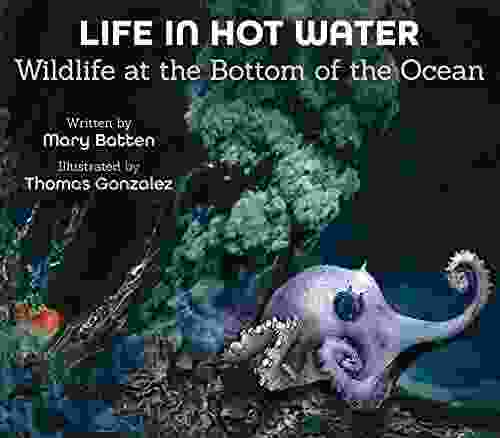Wildlife At The Bottom Of The Ocean: Exploring a Hidden World of Wonders

<p>In this article, we will embark on a captivating journey to explore the incredible wildlife that calls the bottom of the ocean home. From vibrant coral reefs to enigmatic creatures that defy our imagination, we will uncover the hidden world that lies beneath the surface. Let us dive into the depths and discover the wonders that await us.</p><p>Hydrothermal vents are geological wonders that spew hot, mineral-rich water from the Earth's crust into the cold depths of the ocean. These vents create unique ecosystems that support a diverse array of life. The extreme conditions around hydrothermal vents, including high temperatures, low oxygen levels, and high pressure, would seem inhospitable to most organisms. However, they have become havens for specialized creatures that have evolved to harness the unique energy sources available here.</p> <p>Giant tube worms, with their towering crimson bodies, are among the most iconic inhabitants of hydrothermal vents. These worms derive their sustenance not from sunlight, but from the chemicals spewing from the vents. They host symbiotic bacteria within their tissues, which use chemosynthesis to convert inorganic compounds into organic matter. This process, independent of sunlight, sustains the entire ecosystem around hydrothermal vents.</p><p>Cold seeps are another type of geological formation that supports thriving ecosystems at the bottom of the ocean. Unlike hydrothermal vents, cold seeps release cold, methane-rich fluids. These fluids provide energy for a different group of specialized organisms, including mussels, tube worms, and clams. The methane, derived from the decomposition of organic matter, sustains these creatures through a process called methanotrophy.</p> <p>The communities around cold seeps are often dominated by large aggregations of mussels. These mussels have evolved to withstand the low oxygen levels and high sulfide concentrations found at cold seeps. They form dense colonies that provide habitat for a variety of other organisms, creating a diverse and vibrant ecosystem in the otherwise desolate depths.</p><p>Deep-sea corals are marvels of nature that form intricate and diverse structures at the bottom of the ocean. These corals thrive in the cold, dark depths, where they provide habitat for a multitude of marine organisms. Unlike their shallow-water counterparts, deep-sea corals do not require sunlight for survival. Instead, they rely on tiny organisms called zooxanthellae that live in their tissues, providing them with essential nutrients.</p> <p>Deep-sea corals grow slowly, forming massive structures that can take centuries or even millennia to develop. They create complex underwater landscapes, ranging from delicate fans to towering mounds. These structures provide shelter, feeding grounds, and breeding sites for countless marine creatures, making them essential components of the deep-sea ecosystem.</p><p>The depths of the ocean are cloaked in perpetual darkness, where sunlight cannot penetrate. However, many creatures that inhabit this world have evolved ingenious ways to produce their own light. Bioluminescence is a fascinating phenomenon where living organisms emit light through chemical reactions. It serves various purposes, including attracting prey, deterring predators, and communicating with each other.</p> <p>Anglerfish, jellyfish, and deep-sea dragons are just a few examples of the many bioluminescent creatures that illuminate the ocean's depths. Their mesmerizing light displays create a captivating spectacle, transforming the darkness into a radiant underwater world. Bioluminescence plays a crucial role in the survival and reproduction of these creatures, making it an essential aspect of the deep-sea ecosystem.</p><p>As we continue to unravel the mysteries of the deep sea, we gain a greater appreciation for the interconnectedness of all life on Earth. The wildlife at the bottom of the ocean is a vital part of our planet's ecosystems, and understanding their role is essential for preserving the health and balance of our oceans for generations to come.</p><p>With stunning photography and captivating storytelling, **Wildlife At The Bottom Of The Ocean** will transport you to a world of wonder and discovery. It is a must-read for anyone interested in marine biology, oceanography, or the boundless beauty of our planet.</p>5 out of 5
| Language | : | English |
| File size | : | 51378 KB |
| Print length | : | 40 pages |
Do you want to contribute by writing guest posts on this blog?
Please contact us and send us a resume of previous articles that you have written.
 Book
Book Novel
Novel Page
Page Chapter
Chapter Text
Text Story
Story Genre
Genre Reader
Reader Library
Library Paperback
Paperback E-book
E-book Magazine
Magazine Newspaper
Newspaper Paragraph
Paragraph Sentence
Sentence Bookmark
Bookmark Shelf
Shelf Glossary
Glossary Bibliography
Bibliography Foreword
Foreword Preface
Preface Synopsis
Synopsis Annotation
Annotation Footnote
Footnote Manuscript
Manuscript Scroll
Scroll Codex
Codex Tome
Tome Bestseller
Bestseller Classics
Classics Library card
Library card Narrative
Narrative Biography
Biography Autobiography
Autobiography Memoir
Memoir Reference
Reference Encyclopedia
Encyclopedia Margaret Weis
Margaret Weis Mohammad Noori
Mohammad Noori Oliver Heath
Oliver Heath Mark Hampton
Mark Hampton Sandra Mendelson
Sandra Mendelson Trish Morey
Trish Morey Micah Mckinney
Micah Mckinney Oberto Falco Airaudi
Oberto Falco Airaudi Thomas A Schwandt
Thomas A Schwandt Marvin Terban
Marvin Terban Soumendra Mandal
Soumendra Mandal Patricia Lay
Patricia Lay Paul T Bartone
Paul T Bartone Maria M Meyer
Maria M Meyer Martin S Matthews
Martin S Matthews Pati Bielak Smith
Pati Bielak Smith Thea Gallo Becker
Thea Gallo Becker Michael B Abbott
Michael B Abbott Marco Maria Maiocchi
Marco Maria Maiocchi Nyasha Junior
Nyasha Junior
Light bulbAdvertise smarter! Our strategic ad space ensures maximum exposure. Reserve your spot today!

 Edwin CoxUnlock the Latest Advancements in Concrete Technology: Proceedings of Italian...
Edwin CoxUnlock the Latest Advancements in Concrete Technology: Proceedings of Italian...
 J.R.R. TolkienDirect Current Fundamentals: Your Gateway to Electrical Engineering Mastery
J.R.R. TolkienDirect Current Fundamentals: Your Gateway to Electrical Engineering Mastery William ShakespeareFollow ·6.5k
William ShakespeareFollow ·6.5k Kevin TurnerFollow ·4.8k
Kevin TurnerFollow ·4.8k Desmond FosterFollow ·11k
Desmond FosterFollow ·11k Jan MitchellFollow ·15.9k
Jan MitchellFollow ·15.9k Devin RossFollow ·17.6k
Devin RossFollow ·17.6k Ralph TurnerFollow ·17.8k
Ralph TurnerFollow ·17.8k Dillon HayesFollow ·14.9k
Dillon HayesFollow ·14.9k Heath PowellFollow ·14k
Heath PowellFollow ·14k

 Ralph Ellison
Ralph EllisonIntelligent Video Surveillance Systems: The Ultimate...
In a world...

 Jeffrey Cox
Jeffrey CoxThe Origins of the Modern World: A Journey to the Roots...
Embark on an Extraordinary...

 Paulo Coelho
Paulo CoelhoUnlock the Power of Integrated Medical Imaging with...
In the rapidly evolving...

 Charles Reed
Charles ReedThe Christ of the Covenants: Unlocking the Mystery of...
Embark on a Profound...

 Elton Hayes
Elton HayesComputational Hydraulics: A Comprehensive Guide for...
In the realm of fluid dynamics,...
5 out of 5
| Language | : | English |
| File size | : | 51378 KB |
| Print length | : | 40 pages |










